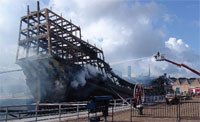 The Prins Willem, the replica Dutch East Indiaman destroyed by fire a few days ago, was an unusual ship. She was built in 1985 in in Friesland in 1985 as an exhibit at the Nagasaki Holland Village open-air museum in Japan. The Japanese theme park was closed and the Prince Willem returned to the Netherlands in 2003 and had been moored at Den Helder. (Interestingly enough, at least to me, the Nagasaki Holland Village park was replaced by a newer and larger Dutch based theme park Huis Ten Bosch also in Nagasaki.)
The Prins Willem, the replica Dutch East Indiaman destroyed by fire a few days ago, was an unusual ship. She was built in 1985 in in Friesland in 1985 as an exhibit at the Nagasaki Holland Village open-air museum in Japan. The Japanese theme park was closed and the Prince Willem returned to the Netherlands in 2003 and had been moored at Den Helder. (Interestingly enough, at least to me, the Nagasaki Holland Village park was replaced by a newer and larger Dutch based theme park Huis Ten Bosch also in Nagasaki.)
The ship has been operated as tourist attraction by Libéma, a diversified Dutch entertainment company. News reports suggest that Libéma plans on rebuilding the ship. The ship was built using a steel frame which appears to have survived the fire.
The Prins Willem replica was not universally beloved. Critics had complained that she was a “Disney” replica, not sufficiently historically accurate with too much freeboard, oddly arranged cabins and no hold to speak of (an odd feature for a replica of the largest merchant-man of her time.) One observer referred to her as a “Disneyfied steel butterbox.”
To be fair, the ship was designed and built to be an exhibit at a theme park, so historical accuracy may not have been the first consideration. Even the replica of the HMS Bounty built for the move, Mutiny on the Bounty, was built to Admiralty plans of the ship, yet was scaled up by roughly 30% to allow for movie cameras to fit below decks. Nevertheless the Prins Willem does raise an interesting question as to what liberties modern designers should take when designing and building a “replica” ship. I’m not sure that the question has an easy or even a single answer
